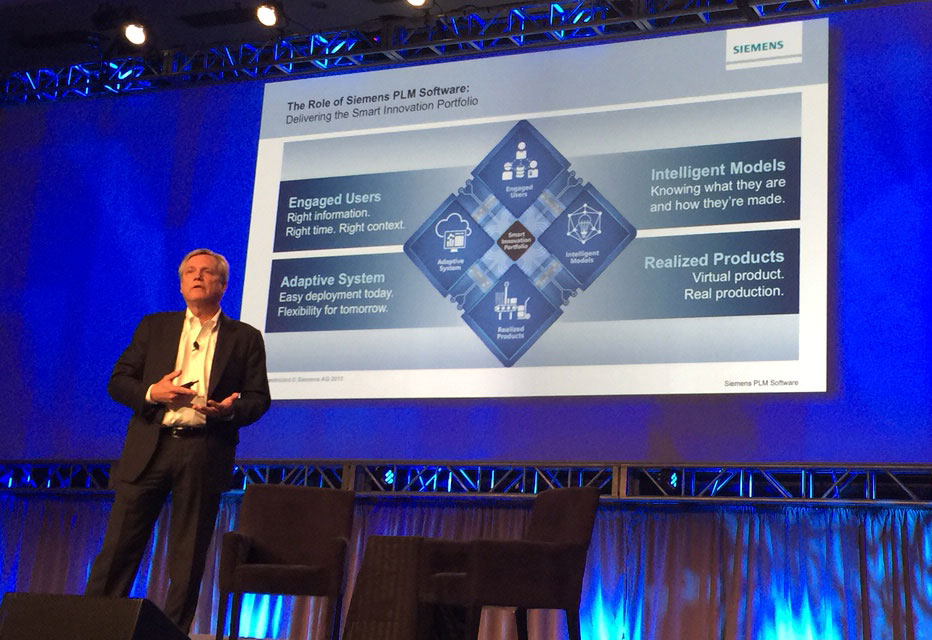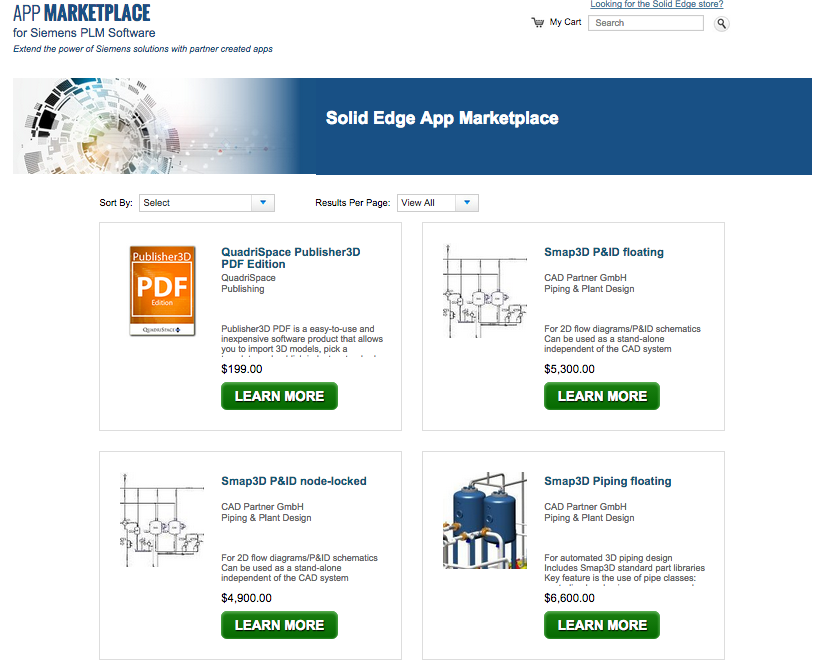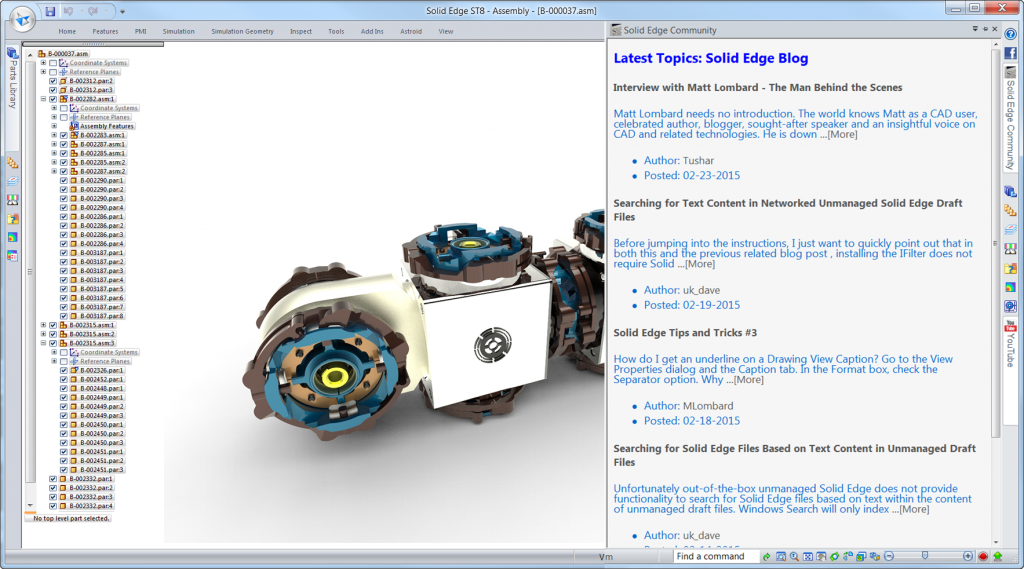
Siemens PLM Software President and CEO Chuck Grindstaff opens the 2015 Siemens PLM Connection Americas User Conference.
Latest News
May 21, 2015
 Siemens PLM Software President and CEO Chuck Grindstaff opens the 2015 Siemens PLM Connection Americas User Conference.
Siemens PLM Software President and CEO Chuck Grindstaff opens the 2015 Siemens PLM Connection Americas User Conference.The storms cleared away from the skies above Dallas just in time for the sun to shine on the 2015 Siemens PLM Connection Americas User Conference hosted by the PLM World user community May 18-21. Likewise, Siemens PLM Software executives shed some light on the company’s plans to help engineers innovate in the increasingly connected world.
Siemens PLM Software President and CEO Chuck Grindstaff called out social, mobile and analytics as “mega trends” that are revolutionizing business and challenging manufacturing. “These transformation are significant in that they do have the possibility of completely turning business models on their heads,” he said.
The results of these trends can be seen in the technologies grabbing headlines these days: deep learning, self-driving cars, custom manufacturing, the smart grid, the Internet of Things, automation and robotics.
“The process of innovation is changing,” Grindstaff said. “We need to have the tools and techniques and systems to support that change in a way that can help you be more competitive, go faster and meet customers’ needs.”
Big Data and the Cloud
One of those tools is Omneo Performance Analytics (PA), which was released at the conference. Omneo, a quality management platform developed by Camstar, which Siemens acquired last year, helps move Siemens’ PLM Software further into the aftermarket. Omneo PA was designed to deliver product performance intelligence from big data analytics.
“The solution monitors data across the entire supply chain and customer experience, while analyzing billions of data combinations in seconds,” according to a press release. “By revealing the hidden intelligence that pinpoints the source of product issues, Omneo PA delivers proactive analysis for big data.”
At the conference, Steve Bashada, senior VP, Cloud Services for Siemens PLM Software, said most companies have never seen all their data in one place, preventing them from seeing the whole picture. He said Omneo helps its users — like Dell and Bose, two of the largest — see potential “red flag” manufacturing issues faster so they can be resolved immediately.
Bashada: Dell has “63 stories where Omneo was invaluable to them saving millions of $” #plmconx pic.twitter.com/THnQyx1mz5
— Desktop Engineering (@DEeditor) May 18, 2015
“Omneo Performance Analytics harnesses the full potential of this powerful technology — changing the way companies understand and improve their products,” Bashada was quoted in a press release. “Using data from sources including field service, manufacturing, CRM, ERP and the Internet of Things (IoT), Omneo Performance Analytics enables companies to identify and resolve problems before they reach their customers — the ultimate goal of any business.”
The discovery capabilities in Omneo PA provide rapid combination analysis of all possible data sets, according to the company. Discovery results identify and display the highest contributing factors to data anomalies. The graphical monitoring capability in Omneo PA provides a view of product performance so companies can consistently track current and emerging trends related to their products.
Bashada: Omneo is intended to bring together disparate data sources so different users can analyze it. #plmconx pic.twitter.com/8ET25eUM0r — Desktop Engineering (@DEeditor) May 18, 2015
Bashada also revealed some of Siemens PLM Software’s cloud computing plans, calling Simens PLM Software’s Solid Edge streaming on the cloud “a window into the future ... a perfect example of adapting technology to the cloud to make it better.” Right now, Siemens PLM Software’s Teamcenter is fully certified for Amazon Web Services, but Bashada says it will also be on Microsoft’s cloud platform, Azure, within 6 to 9 months.
“The CIOs I talk with tell me they’re going to the cloud no matter what,” Bashada said. CIOs are accepting the cloud because it solves so many of their problems, he said, and they realize its security is better than what most companies can provide on their own.
Bashada: The world has changed on the Cloud. Development is more efficient and you can move faster. It should be part of your plan. #plmconx
— Desktop Engineering (@DEeditor) May 18, 2015
Solid Edge ST8 Released
The latest release of Siemens’ Solid Edge software (Solid Edge ST8) includes enhancements and new functionality designed to help users increase design speed and improve their ability to leverage synchronous technology, the company says, while providing greater flexibility in choice of platform and purchasing options. Two of the highlights include the ability to run the full version of Solid Edge ST8 on tablets running Microsoft’s Windows 8.1 operating system and a new Solid Edge App Marketplace mobile app.
 Siemens PLM Software’s new Solid Edge App Marketplace. Image courtesy of Siemens PLM Software.
Siemens PLM Software’s new Solid Edge App Marketplace. Image courtesy of Siemens PLM Software.Other new Solid Edge ST8 features and enhancements include:
- Simplification of large and complex assembly capabilities
- Ability to simulate and predict kinematic conditions
- Extended access to in-product learning tools, online community and the new Solid Edge App Marketplace
- Options to speed drawing changes
- Ability to recognize a finger versus a stylus for touchscreen use on Microsoft’s Surface Pro 3
 Solid Edge ST8 provides access to in-product learning tools and the Solid Edge online community forum. The forum is always accessible to users, even during design sessions. Image courtesy of Siemens PLM Software Inc.
Solid Edge ST8 provides access to in-product learning tools and the Solid Edge online community forum. The forum is always accessible to users, even during design sessions. Image courtesy of Siemens PLM Software Inc.Solid Edge ST8, was chosen as Desktop Engineering’s Pick of the Week. Read all about it here.
Industry Focus
Siemens also launched a new product lifecycle management (PLM) software and services solution at the conference. It is aimed at enhancing efficiency for the global Energy & Utilities industry. According to the company, the solution uses Siemens’ Teamcenter portfolio to digitalize capital project management processes, such as bid response management, and is specifically tailored to Energy & Utilities industry business processes.
The new solution, part of Siemens’ Industry Catalyst Series offerings, includes a deployment accelerator. The Catalyst series was released in 2013. Read more about the company’s move to industry-specific solutions here.
Siemens says the latest Catalyst offering is intended to help companies in the Energy & Utilities industry enhance operational efficiencies by creating an enterprise-wide technology platform to support the capture, sharing and digitalization of capital project management processes. Siemens PLM Software will work with alliance partners like Accenture on deployments in key accounts.
“Our new bid management solution has significantly improved our internal process,” said Balasubramanian Jayaraman in a press release. Jayaraman is global head, Strategy & Cost Out, Siemens Process Industries & Drives, Oil, Gas & Marine. “The bidding process can be very complicated, requiring us to pull together technologies across many departments to address the needs of our customers. With this new Teamcenter solution, we are able to efficiently manage customer requirements, rapidly pull together our sales proposals in a digital format, collaborate on the bid, and deliver the bid response back to the customer 30 percent faster than before and with a 40% reduction in bid cost.”
Energy wasn’t the only industry in the spotlight at the conference. Keynote presenters included Craig Brown, General Motors’ PLM leader. Brown, a former aerospace engineer, said when he moved to the automotive industry he was surprised it hadn’t already embraced simulation.
“They just wanted to build a car and drive it,” to test it, he said. GM’s “Road to Lab to Math” strategy helped the company reduce its reliance on physical testing. He said virtual engineering is helping the company compete in an increasingly complex product development environment and meet more stringent fuel economy standards.
Brown on GM’s product complexity challenges. Auto industry has added complexity & decreased time to market. #plmconx pic.twitter.com/4WukMhV0uE — Desktop Engineering (@DEeditor) May 18, 2015
The next challenge for GM’s product development process is to integrate Teamcenter with SAP for data management. Brown said Active Workspace, an interface for Teamcenter designed to provide a streamlined PLM user experience, is part of the company’s future plans.
Check out some of Active Workspace’s functionality in the video below.
The opening keynoter on day 2 of the conference, David Foulkes of Brunswick Corp. said the company’s Mercury Marine brand uses product development as a competitive advantage.
“At Mercury Marine, we launch a new product every 4 to 6 weeks,” he said. “Our big thing is keeping the product portfolio ahead of the competition.”
Foulkes said that type of speed and agility wouldn’t be possible without structured data and a searchable database that lets the company easily make use of past design work.
Foulkes’ on how to develop new products fast & efficiently: plan 1st, keep it simple, do it right 1st time. #plmconx pic.twitter.com/F7jASG7FlY
— Desktop Engineering (@DEeditor) May 19, 2015
Technology and Responsibility
Foulkes and Brown gave an inside perspective on how simulation led design and data analysis are allowing manufacturers to quickly create products that consumers want. As Foulkes put it, they don’t spend time engineering and re-engineering products people don’t want. But no one brought the idea of consumer-centric design engineering home like the opening keynote presenter, Captain Gene Cernan.
The last man on the moon, Cernan is a former naval officer, electrical engineer, fighter pilot and has been to space three times, including commanding the Apollo 17 mission in 1972, the final Apollo lunar landing. His remarks at the 2015 Siemens PLM Connection Americas User Conference centered on the importance of using technology as a tool, not a crutch and on taking personal responsibility for the engineering behind the products you create.
“Technology is important, but great things require a human endeavor by people who are not afraid to fail,” he said. “It was the engineers and other behind-the-scenes support who took responsibility for the technology that took us to the moon ... When we went to the moon, we went with half a million people who took ownership of the task ... What we took ownership of was not going to fail.”
Cernan didn’t mince words about his feelings on the current state of the U.S. Space program.
“I drove a car on the moon. Today we cannot put an American in space on an American spacecraft. How do you feel about that?” he asked the audience. He said President Kennedy would be “distraught” with the state of the space program today, more than 50 years after the president challenged America with the goal of “landing a man on the Moon and returning him safely to the Earth.”
However, Cernan was ultimately optimistic that we would return to the moon and go to Mars because of technological advancements and the instinctive curiosity of humankind. (Read more about the engineering behind the Mars Rover here and more about the privatization of the space program here.)
Cernan: We’re going to go back to the moon and go on to Mars as soon as we get things straight in Washington #plmconx pic.twitter.com/pekQUdXr3e
— Desktop Engineering (@DEeditor) May 18, 2015
“If I could go to the moon before half this audience was born, what can’t you do?” he asked. “What can’t your kids do?
Subscribe to our FREE magazine, FREE email newsletters or both!
Latest News
About the Author
Jamie Gooch is the former editorial director of Digital Engineering.
Follow DE





